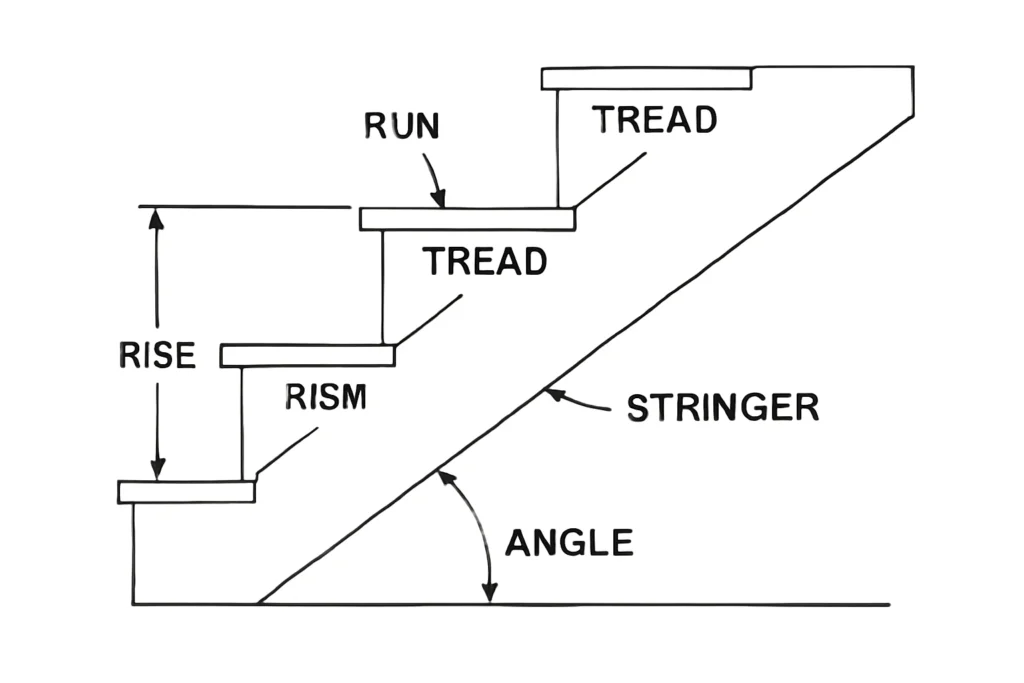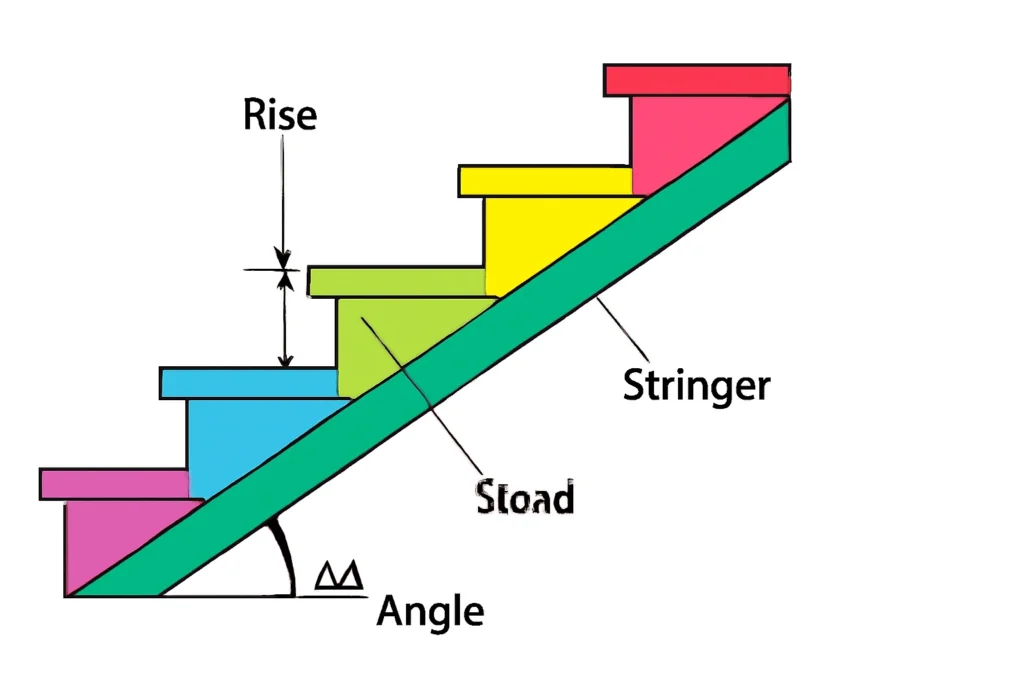Stair Calculator
Easily calculate rise, run, height, and steps with our Stair Calculator. Perfect for safe, accurate, and code-compliant stair design.
- Number of steps.
- Individual rise (height of each step) and run (depth of each step).
- Total stair length and angle.
- Stringer dimensions (the structural support under the steps).
- Required materials based on your design.

Stair calculators are available online and as apps, many featuring advanced options like tread thickness, nosing, and stringer customization. They can also provide 3D visualization of your stair design, helping you see how it fits into your space before construction begins.
Unique Features of Modern Stair Calculators
- Customizable Parameters: Adjust tread thickness, stringer type, material estimates, nosing design, and even handrail height, giving full control over comfort and style.
- 3D Visualization: Some calculators let you view and adjust your stairs in a virtual model, helping communicate and refine your design before it’s built.
- Material Calculation: Instantly estimate materials—preventing costly over-purchases and inefficient cuts.
- Versatility in Stair Types: Calculate for straight, L-shaped, U-shaped, spiral, winder, and more—ideal for professionals and homeowners with unique space constraints.
- Compliance with Codes: Some calculators include local building code checks, ensuring designs are safe and legal.
Step-by-Step Guide—Using a Stair Calculator
- Measure the Total Rise: Vertical distance between the lower and upper floors.
- Select the Ideal Rise and Run: Usually, a safe rise is between 7 and 7.5 in, and the run is 10–11 in, but codes and comfort may alter these values.
- Calculate Number of Steps: Divide total rise by ideal rise.
- Check Actual Rise: Divide total rise by the number of steps; adjust to make all steps equal.
- Calculate Total Run: Multiply number of steps by run (depth of each step).
- Estimate Materials & View Visualization: Let the tool generate material lists and a preview, ensuring what you see is what you get.

Here’s an overview of essential terms you’ll encounter in staircase design:
| Term | Definition |
|---|---|
| Tread | The horizontal part where you step; depth is crucial for comfort. |
| Riser | Vertical part between treads (may be open or enclosed). |
| Nosing | The front edge of the tread that protrudes over the riser improves safety and comfort. |
| Stringer | Sloped supports running along the bottom sides of the steps carry the load. |
| Baluster | Vertical posts supporting a handrail. |
| Handrail | Horizontal or angled rail for safety. |
| Newel | Larger vertical post at the start, end, or turn of a staircase. |
| Landing | Flat area between flights of stairs; breaks long runs for rest and safety. |
| Step | Combination of tread and riser. |
| Stairwell | Vertical shaft in a building for stairs. |
Common Building Codes for Stairs (India Focus)
- Minimum Width: In residential buildings, staircases must be at least 0.9 m wide. Larger apartments or public buildings require wider stairs, e.g., 1.25–2.0 m for assembly spaces.
- Rise and Run: Maximum rise per step is typically 190 mm (7.5 in), with minimum tread depth 250 mm (10 in).
- Handrail Height: Should be at least 900 mm (90 cm) above each step.
- Baluster Spacing: Gaps between balusters must not exceed 100 mm (10 cm) for child safety.
- Number of Staircases: Buildings over a specific height/area may need two staircases, often one enclosed for fire safety.
- Landings: Required at changes in direction or between long flights; dimensions must comply with width and safety rules.
Always consult local codes, especially the National Building Code of India, for additional requirements regarding materials, fire escape stairs, and accessibility.
Frequently Asked Questions
What is a stair calculator used for?
A stair calculator is used to determine the dimensions and number of steps needed for a staircase by calculating parameters like total rise, run, tread length, riser height, and stringer length to ensure safe and code-compliant construction.
How do I enter the total rise and run in a stair calculator?
Enter the total vertical height from the lower floor to the upper floor as the rise and the horizontal distance of the staircase’s base as the run. The calculator then determines the number of steps and dimensions for each step.
What is the ideal stair angle for safety and comfort?
The ideal stair angle typically ranges between 30° and 37° to provide safe and comfortable ascent and descent.
How is the number of steps calculated?
The number of steps is the total rise divided by the riser height, usually limited to a maximum riser height of about 7.75 inches (19.7 cm) according to building codes for safety.
What measurements are needed for accurate calculation?
You need the total rise (vertical height), total run (horizontal length), desired tread width, and sometimes the preferred stair width or stringer thickness.
Conclusion
A stair calculator is more than a convenience—it’s a vital tool for safe, efficient, and beautiful stair design. Modern calculators offer unique and advanced features that let users customize, visualize, and ensure full code compliance. Understanding terminology and codes not only enhances safety but also brings out the best in your home’s design. With technology and a clear grasp of stair definitions and codes, your next staircase project will stand out for its comfort, compliance, and appeal.
